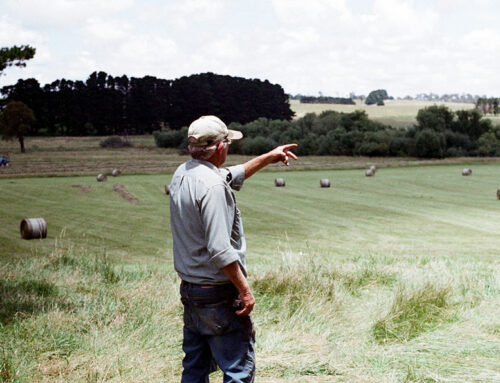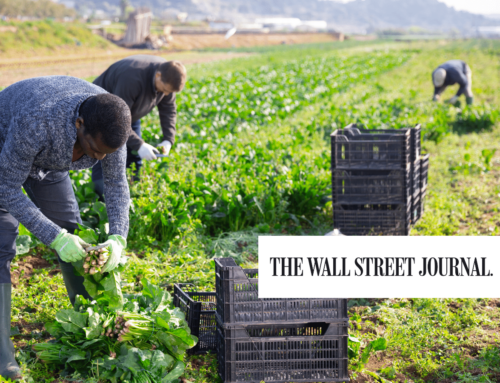Where to start with the 2018 farm bill? One description of it: “Could have been worse.” That’s worse than damning with faint praise, and sets a terribly low bar for a bill that, by some estimates, now approaches $900 billion. And the final 2018 farm bill “compromise” that’s been released is exactly as bad as expected. Let us count the ways.
1. Making Absentee Farming Great Again
Bill eliminates work requirements for farmers
Looking for an easy side hustle? Want the benefits of farm income without the hassle of actually getting dirt under your nails? You’re in luck.
The Farm Bill ensures you and members of your extended family who run a “family farm” can annually receive $125,000 in subsidies ($250,000 if you are married) if you provide “active personal management only,” even from afar. Management is very vague. Participating in conference calls about what to plant, where to sell crops, securing financing, even filling out USDA subsidy program paperwork all qualify. The best part, you can do this from the comfort of your own Manhattan penthouse!
The conference agreement drops a Senate provision (Sec 1704) that would have required that farm subsidy recipients who did not actually work on the farm make a “substantial contribution” of management to receive taxpayer subsidies. At 25 percent of the annual management tasks or 500 hours annually (a mere three months of full time employment) this was apparently too burdensome for armchair agriculturalists.
So now you too can start farming by Facetime™ to harvest taxpayer cash. In 2015 taxpayers shelled out $2.7 billion in farm welfare payments to thousands of recipients with no requirement that they live or even step foot on the farm. The largest operation, consisting of 34 separate individuals or LLCs, received $3.7 million after 25 individuals plus 10 spouses claimed their checks through “management only.” Great non-work if you can get.
2. Expanding (Adding) the Farm Subsidy Family Tree
Family farm loophole expands to the cousins, nieces, and nephews
It’s the holiday season, and the farm bill will deliver gifts of taxpayer cash to your cousins, nieces, and nephews.
Section 1703 increases the pool of potential “family members” that can qualify to receive subsidies as part of a so-called “family farm.”
Farming operations no matter how large face no limit on the number of individuals who can qualify for their own separate payment limit for farm program subsidies of up to $125,000 per year ($250,000 if you are married) as long as each person is a family member. Adding “first cousins, nieces, and nephews” to USDA’s definition of “family” may increase the amount of subsidies going to so-called family farms, including mega joint ventures and general partnerships, without any real increase in risk. These farm income subsidy programs don’t require a person live or work on the farm.
By adding new members to the farm subsidy family tree, the bill will direct taxpayer cash to those who know how to farm the program.
3. Reversing 30 years of progress on common sense limits to subsidy programs
Millionaire households eligible for income subsidies
The Farm Bill conference agreement reverses more than 30 years of progress in focusing farm safety net programs on farmers with an actual need. The bill abandons Senate Section 1706 that made individuals with an annual adjusted gross income (AGI) exceeding $700,000 ineligible for farm income subsidy programs. Instead the bill sets $900,000 as the cutoff point for income subsidy eligibility.
AGI is income after deductions and costs are removed. And the limit is actually doubled for married couples ($1.8 million). And with creative accounting can be made even higher.
So individuals with an interest in a farm business who net $899,999 in income can receive taxpayer subsidies for that income.
4. Shallow loss programs dig deeper into the treasury
Annual choice of switching between ARC and PLC ensures higher payments
Section 1105 Producer Election allows agricultural businesses to once again make a choice between participating in so-called “shallow loss” programs created in the 2014 Farm Bill. This election would apply starting in crop year 2019 (for most crops planted next spring, but some like winter wheat, that are in the ground now). But unlike in 2014, agricultural businesses can change their election starting in 2021. And do it every year thereafter if they choose.
As a reminder, the 2014 Farm Bill created two main programs to replace direct payments for farmers – including Agriculture Risk Coverage (ARC) and Price Loss Coverage (PLC). ARC is a revenue guarantee program that kicks in when the calculated “actual revenue” for a covered commodity falls short of a guaranteed level and is based on the average price and yield experienced in a county. PLC is a target price program that makes payments to agricultural businesses when the national average price of a particular crop falls below a price set in the Farm Bill.
ARC and PLC are in addition to subsidized crop insurance and constitute the top layers of the agricultural income subsidy sandwich. ARC and PLC are vastly over budget. They’re on pace to cost $48 billion instead of the $27 billion they were estimated when the 2014 farm bill was adopted.
Adding the annual election secret sauce will simply allow agricultural businesses to work the equation backward and dip even deeper into the Treasury.
5. Requires Excessive subsidies to developers of new crop insurance policies
Taxpayers must now foot bill for private companies to develop policies
The conference agreement puts taxpayers on the hook to cover research and development costs even when those costs are “unreasonable,” handing a millions-of-dollars end of year gift to crop insurance special interests.
Section 11120 in the conference report includes language to force taxpayers to reimburse private companies for millions of dollars in costs the companies claim when developing and maintaining new subsidized crop insurance policies for the program. Even when USDA finds the claims “unreasonable.”
New federally subsidized crop insurance policies can be developed when the farm bill sets “research and development” priorities for the Risk Management Agency (RMA), or when organizations or institutions outside of RMA submit concept proposals. This process, known as 508(h), has resulted in dozens of new policies over the years. It’s also sprung forth a cottage industry of players who make a lucrative return on their development of policies.
The farm bill takes discretion away from RMA and spells out exactly what the crop insurance corporation board can find as “reasonable” costs in developing and maintaining new policies. But even here there is an escalation clause in that the bill adds the language “and actual” after “reasonable.” So taxpayers have to pay for inflated, farm bill-defined “reasonable” costs “and actual” costs even if those are by the farm bill’s very own definition, unreasonable!
This is just yet another example of how the farm bill is less a vehicle for creating a cost-effective safety net for all of agriculture and more a package of parochial payouts for the ag committee’s pals.
6. Makes Wasteful Bioenergy Subsidies a Permanent Entitlement
Wasteful Rural Energy for America Program now made permanent
In 2008, the Rural Energy for America Program (REAP) was created with the intent to increase the use of wind, solar, hydro, and other renewable energy projects in rural areas.
Instead, the program has been hijacked to fund pet projects for noticeably not renewable or innovative special interests such as corn ethanol blender pumps, equipment upgrades for corn ethanol facilities in the name of “energy efficiency,” biodiesel and biomass production, grain dryers, irrigation equipment, and the construction of confined poultry feeding operations (aka CAFOs). Better yet, taxpayer dollars are squandered on catfish oxygen monitoring systems, wine cooling tanks, tobacco production equipment, and replacement of “syrup evaporators.”
Rather than contributing to an overall policy goal, REAP is a grab bag of goodies for multiple special interests. The farm bill conference committee should have axed mandatory funding for this wasteful program (as the House farm bill recommended) so individual companies and businesses could cover these normal costs of doing business themselves. Instead, Christmas came early for catfish, tobacco, ethanol, biodiesel, biomass, and other special interests as the farm bill conference report contains $50 million in mandatory funding each year for REAP in perpetuity. No other farm bill energy title program received permanent funding in this farm bill or in past bills, instead having to be re-justified every five years when a Farm Bill is debated
But REAP is an exception to the rule and it reeks.
7. Failure to produce savings
Agricultural income safety net programs are neither targeted nor cost-effective
Like every farm bill before it, the 2018 farm bill is set up to be a budget buster. Reports are the bill is estimated to be revenue neutral, but farm bills are always more expensive than they appear, on the magnitude of hundreds of billions of dollars.
The conference agreement appears likely to continue this costly tradition. The bill contains a number of provisions designed to increase taxpayer spending on agricultural income subsidy programs.
Just a few include:
- 1401 Dairy “insurance” premiums being rebated if dairy producers didn’t suffer a loss.
- 1101 The bill establishes a government guaranteed price for Peanuts that is above the actual market price, has been for seven of the last nine years, and the Congressional Budget Office estimates market prices will continue to fall short through at least 2027. Peanut growers are guaranteed payments before they plant.
- 1101 contains an escalator clause for government guaranteed prices of all commodities in ARC/PLC meaning an increase in crop prices could put taxpayers on the hook for prices above the cost of production (profit guarantee).
- 11122 adds numerous mandates for research into providing subsidized crop insurance for a number of crops and growing conditions including additional Citrus policies, tropical storm and hurricane insurance, even though there are already revenue and yield policies covering citrus. A “Local Foods” crop insurance even though producers serving farmers’ markets or other hyperlocal markets can already obtain “whole farm revenue” insurance on their operation.
All of these provisions, and many more, are further examples of how farm bills are not actually designed to help agricultural businesses manage risks that are unmanageable, but instead are used to take every step to move agriculture into a no loss industry by making U.S. taxpayers financially responsible.
8. Plants Parochial Payouts
Pet projects from pulse crops to pet rocks receive funding
Farm Bills are notorious for their pandering to parochial interests.
The 2018 bill is more of the same.
- Sushi rice (temperate japonica rice) continues to receive a special price premium in the PLC program.
- Under the ARC shallow loss program, which makes payments if average county revenue falls below levels recently experienced, counties over 1,400 square miles in size can be subdivided into smaller units if this increases payments. This was originally designed to help mainly Montana, because the counties had to be in states over 140,000 square miles. That requirement was removed, and only 25 counties are allowed now, so we’ll see where else this may apply.
- The National Sheep Industry Improvement Center (Sec. 12102) gets a 33 percent bump in funding (up to $2 million). This a mere five years after the 2013 House Farm eliminated the program.
- 12613 lays a foundation for “natural stone” to become an agricultural commodity program with a study of the feasibility of creating a checkoff program. The 2013 House Farm Bill defeated a mandate to create a commodity checkoff of these pet rocks. This “report” is the first step in undoing this pebble of a taxpayer victory.
9. Replaces markets with mandates
Lawmakers continue to replace market forces with wisdom from Washington.
Farm bills are notorious for Washington’s wisdom supplanting market forces. This one does not change that trend.
The bill continues the failed sugar program. Sugar prices for producers of sugar cane and sugar beets in Section 1301 are protected through price supports and restricting sugar leading consumers to pay more for sugar than in any other country. Small dairy producers are so protected according to Ranking Member Peterson (D-MN) they’d have to try to lose money. The Secretary of Agriculture is also “encouraged” to remind the thousands of communities receiving assistance in the school lunch program of the requirement they “buy American” for much of their food.
In conservation, the agreement increases to 29 million acres the amount of land taxpayers pay farmers not to farm with no guarantee the land enrolled is the type of farmland that should not rationally be cultivated (it’s marginal and thus likely to result in a crop insurance payout or it’s highly erodible and likely leading to increased downstream pollution).
Long story short, there are a plethora of government mandates in agriculture that might seem like good intentions but actually raise the costs for consumers and literally makes the government pick who should succeed or fail rather than allowing producers to succeed on their own merits.
10. Farm Bill Does Not Provide Predictability and Stability for Farmers
Failure to Temper Trump’s Trade War Undercuts the Farm Bill Before It’s Even Adopted
Members of Congress have paraded the farm bill, even the most egregious provisions of the legislation, as necessary to provide predictability and stability for the US agricultural sector when in actuality it does neither.
The single greatest economic threat to agriculture in this country is the continuing trade war with our top trading partners. When President Trump started the trade war by implementing tariffs on steel and aluminum as well as tariffs on China, ag producers were particularly hit hard with retaliatory tariffs.
The farm bill does not eliminate any of the retaliatory tariffs, including major commodities like corn, soybeans, dairy, pork, and beef. Nor does the farm bill reopen markets lost through tariffs or create new markets to replace those ag markets lost.
What the farm bill does do is create even more loopholes for a few ag producers to exploit so they can receive more subsidies. Yet in the grand scheme of things that will not cover the losses the ag sector has experienced due to the trade war and it won’t help the sector move on. Colin Peterson, ranking member for the House Agriculture Committee, even said the farm bill doesn’t do enough to help ag producers affected by the trade war and this and we will need to pass additional spending next year.











Get Social